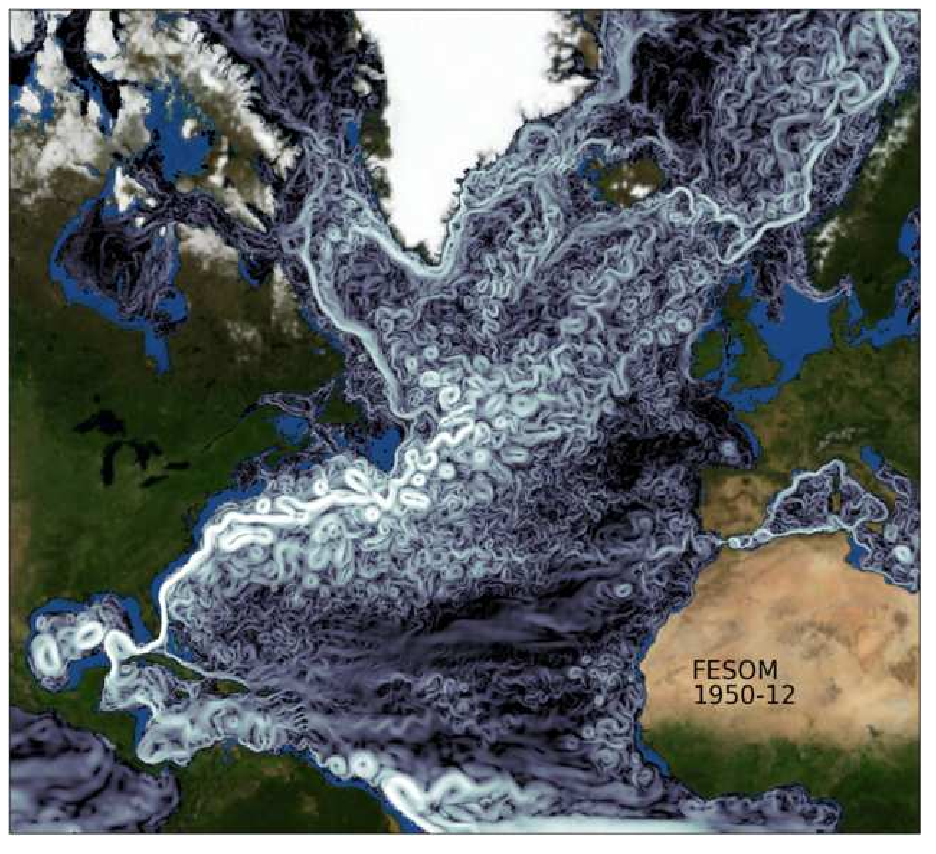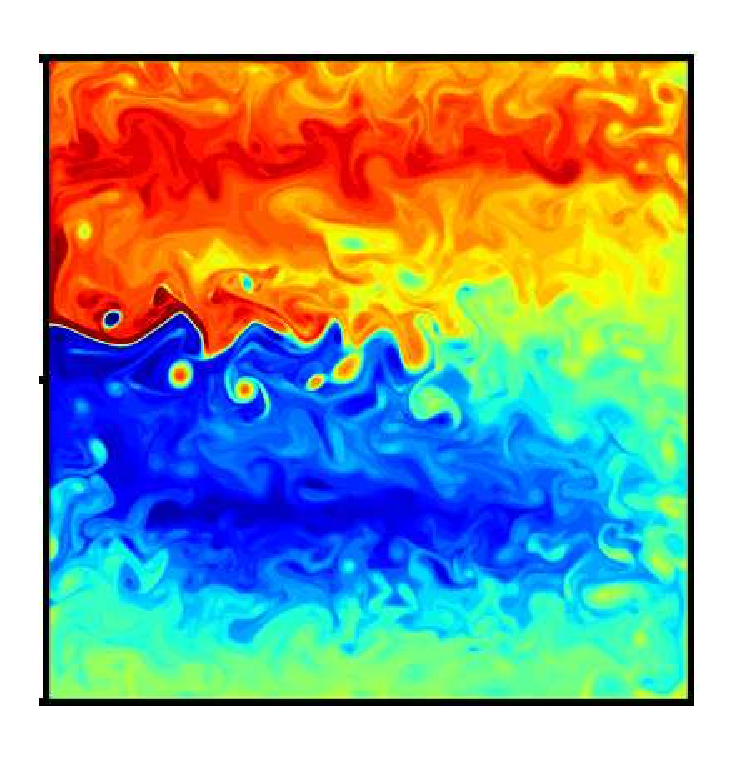Developing Quasi-Geostrophic Coupled Ocean–Atmosphere Model
Project Description
This Project would be ideal for a student who seeks to develop skills in software engineering for computational modelling, scientific computing, data science, geophysical fluid dynamics, and climate science research. It aims for a major overhaul and upgrade of the existing Quasi-Geostrophic Coupled Model (Q-GCM) of the ocean-atmosphere system to convert this model into a versatile modular community code for extremely fast high-resolution climate modelling in arbitrary geometrical setups. The model’s ability to quickly produce global-scope multi-century climate simulations faithfully representing mesoscale ocean–atmosphere interactions would allow it to set the milestones for future research of fundamental climate processes that are currently out of reach for state-of-the-art coupled General Circulation Models (GCMs) due to prohibitive computational expenses of such simulations.
Advancing our understanding of multi-scale climate variability is at the heart of the Project. A particular focus here is on the internal variability of the ocean-atmosphere subsystem of the climate system, which can occur even in the absence of variations in the external forcing. Such variability can generally be classified to fall into one of the following categories:
- internal variability of the oceans;
- internal variability of the atmosphere; and
- coupled ocean–atmosphere variability.
Of course, other factors contribute to the climate variability modes on different levels (e.g., interaction with cryosphere, coupled land–atmosphere processes, and so forth). Most coupled ocean-atmosphere GCMs do not yet adequately discriminate between the scenarios (i)–(iii), because the model dynamics still lacks accurate representation of small-scale processes due to their insufficient horizontal resolutions. In particular, global coupled GCMs do not have the required capability to resolve routinely the oceanic weather represented by multi-scale ensembles of synoptic mesoscale eddies, which evolve in a complicated, spatially inhomogeneous and poorly understood way.


The cutting edge high-resolution ocean modelling efforts, which involve enormous computational expenses https://fesom.de/models/fesom14/ typically produce a single realization worth of a few decades of simulation at most, with marginally accepted dynamical resolution of the eddies achieved at least for midlatitudes (note that at high latitudes the eddies and, hence, required resolutions become even smaller). Many such simulations are also run in the ocean-only context, despite the growing evidence that the mesoscale air-sea interaction affects, in major — and, perhaps, nonlinear ways, — the atmospheric large-scale low-frequency variability (Mathews et al. 2024). However, climate-type simulations not only require hundreds of multi-century runs for robust statistical ensemble predictions, but they also have to consider different environmental scenarios (e.g., for greenhouse gas emissions) and sensitivities to many physical factors. The ability to faithfully characterize the effects of the mesoscale ocean eddies and currents in a coupled, global setting is a major stumbling block in climate research, and is thus one of the grand research challenges of our time.
One way out of this deadlock is to develop accurate statistical–dynamical eddy parameterizations for the use in realistic models, which is a major task of its own. An alternative way, proposed here, is to make use of intermediate-complexity coupled ocean–atmosphere process models capable of accessing new and crucial knowledge about the processes involved, yet casting them in advanced settings that would permit direct comparisons with the real world’s climate variability.
Indeed, driven by the surging demand of climate science, the last two decades witnessed development of idealized, intermediate-complexity, midlatitude, quasi-geostrophic (QG), ocean–atmosphere coupled models, which can routinely resolve oceanic mesoscale eddies (Hogg et al. 2003; Kravtsov et al. 2007; Berloff et al. 2007a). These models are at least 100 times more computationally efficient than the heavy-duty global coupled GCMs. The Q-GCM of Hogg et al. (2003), which is a starting point of this project, couples its oceanic and atmospheric subsystems via ageostrophic boundary layers of both fluids. Aside from the natural limitation of QG models to be formally accurate within the midlatitude belts, these models are cast in the simplest square-basin or channel geometries, which hinders their immediate application to interpreting the observed climate variability. Yet, Q-GCM is a powerful tool for simulating midlatitude coupled climate variability with fully resolved oceanic mesoscale turbulence.
Idealized eddy-resolving ocean and coupled modelling thus far established not only existence and robustness of the intrinsic ocean-only variability dubbed as the rbulent Oscillator (e.g., Berloff et al. 2007b), but also the importance of this variability for the ocean-atmosphere coupled variability (Kravtsov et al. 2007; Kurashina and Berloff 2023a,b). Similar fundamental importance of the eddies for driving decadal variability has been established in the Southern Ocean (Hogg and Blundell 2006). Considering these coupled dynamics in progressively more realistic Q-GCM is of high priority, but this effort requires significant upgrades of the existing modelling capabilities.
Objectives.
The software development objective of the Project is very significant upgrade of the existing Q-GCM, including generation of modular geometrical setups, addition of new physics and incorporation of superior numerical algorithms, as well as the requisite updates to the post-processing tools and software library. The computational objective of the Project is to produce new multi-century simulations in the northern-hemisphere (NH) and southern-hemisphere (SH) model configurations. More specifically, we hypothesize that in the NH case the Atlantic and Pacific oceans will generate their own internal, large-scale decadal-to-interdecadal Turbulent Oscillator variability, which will be coupled through atmospheric teleconnections. In the SH case the situation is likely to be more complicated, as the midlatitude basins will be also connected via the Antarctic Circumpolar Current. The analysis objective of the Project is to gain dynamical understanding of the involved variabilities.
Work Plan.
The starting point for the Project will be the most recent study of the Q-GCM idealized-ocean double-gyre coupling with the atmosphere, in which new, zonally asymmetric coupled variability modes have been discovered and understood (Kurashina and Berloff 2023a,b). The following Q-GCM model developments are envisioned:
Adding the second (rectangular) ocean basin to represent Atlantic-Pacific teleconnections (NB: this configuration can be passed to a Master student for spin-off project);
Adding capabilities for representing (arbitrary and) realistically shaped basins (this requires complete overhaul of the elliptic solver with the matrix capacitance method, and recoding the boundary conditions);
Upgrading advection operators in both ocean and atmosphere components with the high-resolution, efficient CABARET advection scheme (Karabasov et al. 2009);
Adding moist dynamics to the atmosphere (Kravtsov et al. 2022);
Developing realistic NH and SH Q-GCM model configurations (i.e., with two isolated ocean basins; with three ocean basins connected by the circular Southern ocean) and obtaining the corresponding milestone solutions both with high- and low-resolution configurations (the latter will help to quantify effects of the small scales and serve as the basis for eddy parameterizations);
Developing comprehensive post-processing library of numerical routines for both Eulerian and Lagrangian analyses and visualizations of the Q-GCM solutions;
Providing initial analyses of the milestone solutions; disentangling causalities of the ocean-atmosphere and ocean-ocean couplings, as well as understanding the main mesoscale eddy effects and their mechanisms;
Developing mixed-layer model for dynamics of floating tracers, such as plankton and pollutants; this will in effect prepare ground for the coupled ocean-atmosphere modelling with oceanic biochemistry and with global carbon cycle.
The student will benefit from the interdisciplinary nature of the Project that combines a great deal of original and creative research within the remit of software engineering for computational modelling, scientific computing, data science, geophysical fluid dynamics, and climate science. Close interactions with external research partners will be a vital aspect of the Project, ensuring its optimal development and success: Prof. Sergey Kravtsov (University of Wisconsin, USA), Prof. William Dewar (Florida State University, USA) and Prof. Andrew Hogg (Australian National University, Australia). The Project will be a great opportunity for outreaching the climate science community and providing broad and practical impact.
References
- Berloff, P., A. Hogg, and W. Dewar, 2007b: The turbulent oscillator: A mechanism of low-frequency variability of the wind-driven ocean gyres. J. Phys. Oceanogr., 37, 2363–2386.
- Berloff, P., S. Kravtsov, W. Dewar, and J. McWilliams, 2007a: Ocean eddy dynamics in a coupled ocean-atmosphere model. J. Phys. Oceanogr., 37, 1103–1121.
- Hogg, A., and J. Blundell, 2006: Interdecadal variability of the Southern Ocean. J. Phys. Oceanogr., 36, 1626-–1645.
- Hogg, A., W. Dewar, P. Killworth et al., 2003: A quasi-geostrophic coupled model (Q-GCM). Monthly Weather Review, 131, 2261–2278.
- Karabasov, S., P. Berloff, and V. Goloviznin, 2009: CABARET in the ocean gyres. Ocean Modelling, 30, 155–168.
- Kravtsov, S., I. Mastilovic, A. Hogg, W. Dewar, and J. Blundell, 2022: The Moist Quasi-Geostrophic Coupled Model: MQ-GCM 2.0. Geoscientific Model Development, 15, 7449-–7469.
- Kravtsov, S., W. Dewar, P. Berloff, J. McWilliams, and M. Ghil, 2007: A highly nonlinear coupled mode of decadal variability in a midlatitude ocean-atmosphere model. Dyn. Atmos. Ocean., 43, 123–150.
- Kurashina, R., and P. Berloff, 2023b: Low-frequency variability enhancement of the midlatitude climate in an eddy-resolving, coupled ocean-atmosphere model. Part II: Ocean mechanisms. Climate Dynamics, doi:10.1007/s00382-023-06767-x.
- Kurashina, R., and P. Berloff, 2023a: Low-frequency variability enhancement of the midlatitude climate in an eddy-resolving, coupled ocean-atmosphere model. Part I: Anatomy. Climate Dynamics, doi:10.1007/s00382-023-06782-y.
- Mathews, J. P., Czaja, A., Vitart, F., and Roberts, C., 2024: Gulf Stream moisture fluxes impact atmospheric blocks throughout the Northern Hemisphere. Geophysical Research Letters, 51, e2024GL108826. https://doi.org/10.1029/2024GL108826
- Wang, Q., Danilov, S., Sidorenko, D., Timmermann, R., Wekerle, C., Wang, X., … and Schröter, J., 2014: The Finite Element Sea Ice-Ocean Model (FESOM) v. 1.4: formulation of an ocean general circulation model. Geoscientific Model Development, 7(2), 663–693.


